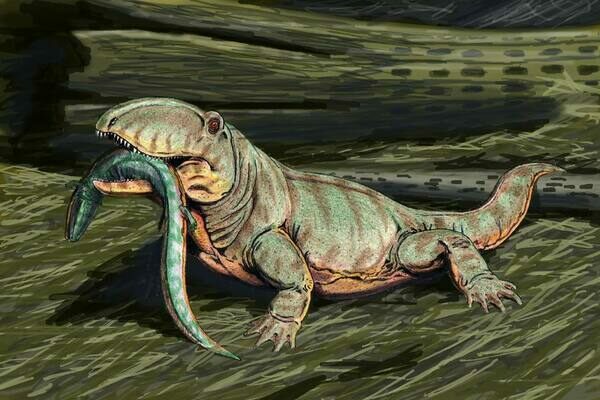This Specimen has been sold.
1.05" Ophiacodon (Permian Synapsid) Jaw Section - Texas
This is a jaw section with four teeth in place of Ophiacodon, an Early Permian synapsis from the Texas Red Beds on Archer County, Texas. It comes in an acrylic display case.
Ophiacodon (meaning "snake tooth") is an extinct genus of synapsids belonging to the family Ophiacodontidae that lived from the Late Carboniferous to the Early Permian in North America and possibly Europe. It had a large skull with a deep snout. It has the longest skull of any early synapsid, reaching up to 20" in one specimen. The jaws are lined with many small teeth. It was larger than most other tetrapods (four-limbed vertebrates) of its time, ranging from 5-10 ft in length.
Ophiacodon most likely lived on land, but paleontologists have sometimes thought that it was semi-aquatic. Anatomical features initially suggesting that it spent much of its time in the water include broad claws that seemed to be adaptations for paddling, thin jaws and numerous small teeth that seemed to be adapted for eating fish, and weakly developed bones. Several of these features are no longer thought to be evidence of an aquatic lifestyle; for example, broad claws are seen in most early tetrapods, even those that are known to have been almost exclusively terrestrial, and the long hindlimbs of Ophiacodon would not have been an effective means of propulsion because the feet were still relatively small and had little surface area over which to form a paddle. Analysis of the vertebrae of Ophiacodon indicate that it was most likely terrestrial and spent little time in water.
Skeletons of Ophiacodon show a fast growth pattern found in birds and mammals called fibrolamellar bone (FLB), suggesting at least partial warm-bloodedness.
Ophiacodon (meaning "snake tooth") is an extinct genus of synapsids belonging to the family Ophiacodontidae that lived from the Late Carboniferous to the Early Permian in North America and possibly Europe. It had a large skull with a deep snout. It has the longest skull of any early synapsid, reaching up to 20" in one specimen. The jaws are lined with many small teeth. It was larger than most other tetrapods (four-limbed vertebrates) of its time, ranging from 5-10 ft in length.
Ophiacodon most likely lived on land, but paleontologists have sometimes thought that it was semi-aquatic. Anatomical features initially suggesting that it spent much of its time in the water include broad claws that seemed to be adaptations for paddling, thin jaws and numerous small teeth that seemed to be adapted for eating fish, and weakly developed bones. Several of these features are no longer thought to be evidence of an aquatic lifestyle; for example, broad claws are seen in most early tetrapods, even those that are known to have been almost exclusively terrestrial, and the long hindlimbs of Ophiacodon would not have been an effective means of propulsion because the feet were still relatively small and had little surface area over which to form a paddle. Analysis of the vertebrae of Ophiacodon indicate that it was most likely terrestrial and spent little time in water.
Skeletons of Ophiacodon show a fast growth pattern found in birds and mammals called fibrolamellar bone (FLB), suggesting at least partial warm-bloodedness.
SPECIES
Ophiacodon
AGE
LOCATION
Archer County, Texas
FORMATION
Nocona Formation
SIZE
1.05" long
CATEGORY
ITEM
#42966
We guarantee the authenticity of all of our specimens.
 Reviews
Reviews













